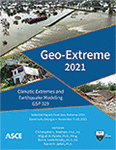Resilience through Data Analytics: Investigating the Shift of Seismic Activities in Oklahoma
Publication: Geo-Extreme 2021
ABSTRACT
The number of earthquakes in Oklahoma in the past decade has seen a multifold increase from its previous average of 25 earthquakes per year. Several studies have suspected a correlation between increased exploration and production activities (e.g., saltwater disposal, hydraulic fracturing) with the increased seismicity in Oklahoma. This study investigates the shift of seismic activities in Oklahoma through data analytics using the Epidemic-Type Aftershock Sequence (ETAS) model and the source parameter approach. It was observed that most earthquakes are induced due to fluid injection. Moreover, the significant earthquakes in Oklahoma with M 5.0+ were induced due to the wastewater injection. Our results suggest shifting of the earthquake hot spots and increased earthquake density from the megashear fault zone toward the Nemaha and central plains fault zones. The proposed modeling approach and findings offer improved understanding and robust tools for anticipation and preparedness against induced earthquakes, leading to earthquake-resilient communities.
Get full access to this article
View all available purchase options and get full access to this chapter.
REFERENCES
Amirlatifi, A., KC, B., Adibifard, M., Vahedifard, F., and Ghazanfari, E. (2021). “Data analytics to investigate the cohort of injection wells with earthquakes in Oklahoma.” Earthquake Spectra - Central and Eastern North America (CENA) Special Issue, 1–21.
Cesca, S., Rohr, A., and Dahm, T. (2013). “Discrimination of induced seismicity by full moment tensor inversion and decomposition.” Journal of Seismology, 17(1), 147–163.
Cornet, F. H., Helm, J., Poitrenaud, H., and Etchecopar, A. (1997). “Seismic and aseismic slips induced by large-scale fluid injections.” Pure and Applied Geophysics, 150(3–4), 563–583.
Davis, S. D. and Pennington, W. D. (1989). “Induced seismic deformation in the Cogdell oil field of west Texas.” Bulletin of the Seismological Society of America, 79(5), 1477–1494.
EIA, U. (2021). “Petroleum and Other Liquids.” <https://www.eia.gov/petroleum/>(Jan. 12, 2020).
Ellsworth, W. L. (2013). Injection-Induced Earthquakes. 341(July), 1–8.
Energy in Depth. (2015). Injection Wells and Earthquakes : Quantifying the Risk. (November), 21.
Hainzl, S., and Ogata, Y. (2005). “Detecting fluid signals in seismicity data through statistical earthquake modeling.” Journal of Geophysical Research, 110(B5), B05S07.
Hainzl, S., and Ogata, Y. (2005). “Detecting fluid signals in seismicity data through statistical earthquake modeling.” Journal of Geophysical Research: Solid Earth, 110(5).
Healy, J. H., Rubey, W. W., Griggs, D. T., and Raleigh, C. B. (1968). “The Denver EarthquakeS.” Science, 161(3848), 1301–1310.
Hincks, T., Aspinall, W., Cooke, R., and Gernon, T. (2018). “Oklahoma’s induced seismicity strongly linked to wastewater injection depth.” Science, 359(6381), 1251–1255.
Horton, S. (2012). “Disposal of Hydrofracking Waste Fluid by Injection into Subsurface Aquifers Triggers Earthquake Swarm in Central Arkansas with Potential for Damaging Earthquake.” Seismological Research Letters, 83(2), 250–260.
Julian, B. R., Miller, A. D., and Foulger, G. R. (1998). “Non-double-couple earthquakes. 1. Theory.” Reviews of Geophysics, 36(4), 525–549.
Keranen, K. M., Savage, H. M., Abers, G. A., and Cochran, E. S. (2013). “Potentially induced earthquakes in Oklahoma, USA: Links between wastewater injection and the 2011 Mw 5.7 earthquake sequence.” Geology, 41(6), 699–702.
Keranen, K. M., Weingarten, M., Abers, G. A., Bekins, B. A., and Ge, S. (2014). “Sharp increase in central Oklahoma seismicity since 2008 induced by massive wastewater injection.” Science, 345(6195), 448–451.
Kumazawa, T., and Ogata, Y. (2014). “Nonstationary etas models for nonstandard earthquakes.” Annals of Applied Statistics, 8(3), 1825–1852.
Langenbruch, C., and Zoback, M. D. (2016). “How will induced seismicity in Oklahoma respond to decreased saltwater injection rates?” Science Advances, 2(11), e1601542.
Lei, X., Ma, S., Chen, W., Pang, C., Zeng, J., and Jiang, B. (2013). “A detailed view of the injection-induced seismicity in a natural gas reservoir in Zigong, southwestern Sichuan Basin, China.” Journal of Geophysical Research: Solid Earth, 118(8), 4296–4311.
Lei, X., Yu, G., Ma, S., Wen, X., and Wang, Q. (2008). “Earthquakes induced by water injection at ∼3 km depth within the Rongchang gas field, Chongqing, China.” Journal of Geophysical Research: Solid Earth, 113(10), 1–12.
Marsan, D., Prono, E., and Helmstetter, A. (2013). “Monitoring aseismic forcing in fault zones using earthquake time series.” Bulletin of the Seismological Society of America, 103(1), 169–179.
OCC. (2016). Earthquake Response Summary.
Ogata, Y. (1999). “Seismicity Analysis through Point-process Modeling: A Review.” Seismicity Patterns, their Statistical Significance and Physical Meaning, Birkhäuser Basel, Basel, 471–507.
Rubinstein, J. L., and Mahani, A. B. (2015). “Myths and Facts on Wastewater Injection, Hydraulic Fracturing, Enhanced Oil Recovery, and Induced Seismicity.” Seismological Research Letters, 86(4), 1060–1067.
USGS. (2020). “ANSS Comprehensive Earthquake Catalog - Search Earthquake Catalog.” <https://earthquake.usgs.gov/earthquakes/>(Jul. 12, 2020).
Walsh, F. R., and Zoback, M. D. (2015). “Oklahoma’s recent earthquakes and saltwater disposal.” Science Advances, 1(5), 1–10.
Walter, J. I., Ogwari, P., Thiel, A., Ferrer, F., Woelfel, I., Chan, J. C., Darol, A. P., and Holla, A. A. (2020). “The Oklahoma geological survey statewide seismic network.” Seismological Research Letters, 91(2 A), 611–621.
Weingarten, M., Ge, S., Godt, J. W., Bekins, B. A., and Rubinstein, J. L. (2015). “High-rate injection is associated with the increase in U.S. mid-continent seismicity.” Science, 348(6241), 1336–1340.
Wynants-Morel, N., Cappa, F., De Barros, L., and Ampuero, J. P. (2020). “Stress Perturbation From Aseismic Slip Drives the Seismic Front During Fluid Injection in a Permeable Fault.” Journal of Geophysical Research: Solid Earth, 125(7).
Zhang, H., Eaton, D. W., Li, G., Liu, Y., and Harrington, R. M. (2016). “Discriminating induced seismicity from natural earthquakes using moment tensors and source spectra.” Journal of Geophysical Research: Solid Earth, 121(2), 972–993.
Information & Authors
Information
Published In
Copyright
© 2021 American Society of Civil Engineers.
History
Published online: Nov 4, 2021
Authors
Metrics & Citations
Metrics
Citations
Download citation
If you have the appropriate software installed, you can download article citation data to the citation manager of your choice. Simply select your manager software from the list below and click Download.
